
Specifications are subject to change without notice
© 2016 Koninklijke Philips N.V.
All rights reserved.
HD3118_UM_V4.0
English
1 Your rice cooker
Congratulations on your purchase, and welcome to
Philips!
To fully benet from the support that Philips oers,
register your product at www.philips.com/welcome.
2 Important
Read this important information leaet carefully before
you use the rice cooker and save it for future reference.
Danger
• Do not immerse the rice
cooker in water, nor rinse it
under the tap.
Warning
• This appliance is not
intended for use by persons
(including children) with
reduced physical sensory
or mental capabilities, or
lack of experience and
knowledge, unless they have
been given supervision or
instruction concerning use
of the appliance by a person
responsible for their safety.
• Children should be supervised
to ensure that they do not
play with the appliance.
• This appliance should
be positioned in a stable
situation with the handles
(if any) positioned to avoid
spillage of the hot liquids.
• This appliance is intended to
be used in household and
similar applications such as:
• sta kitchen areas in shops,
oces and other working
environments;
• farm houses;
• by clients in hotels, motels
and other residential type
environments;
• bed and breakfast type
environments.
• Make sure that the damaged
power cord is replaced by
Philips, a service center
authorized by Philips or
similarly qualied persons in
order to avoid a hazard.
• The appliance is not intended
to be operated by means
of an external timer or a
separate remote-control
system.
• Check if the voltage indicated
on the appliance corresponds
to the local power voltage
before you connect it.
• Only connect the appliance
to a grounded power outlet.
Always make sure that the
plug is inserted rmly into the
power outlet.
• Do not use the appliance if
the plug, the power cord, the
inner pot, the sealing ring, or
the main body is damaged.
• Do not let the power cord
hang over the edge of the
table or worktop on which the
appliance stands.
• Make sure the heating
element, the temperature
sensor, and the outside of the
inner pot are clean and dry
before you put the plug in the
power outlet.
• Do not plug in the appliance
or press any of the buttons
on the control panel with wet
hands.
• Make sure to avoid spillage
on the power connector to
avoid a potential hazard.
• Always follow the instructions
and use the appliance
properly to avoid potential
injury.
Caution
• Never use any accessories
or parts from other
manufacturers or that
Philips does not specically
recommend. If you use such
accessories or parts, your
guarantee becomes invalid.
• Do not expose the appliance
to high temperatures, nor
place it on a working or still
hot stove or cooker.
• Do not expose the appliance
to direct sunlight.
• Place the appliance on a
stable, horizontal, and level
surface.
• Always put the inner pot in
the appliance before you put
the plug in the power outlet
and switch it on.
• Do not place the inner pot
directly over an open re to
cook rice.
• Do not use the inner pot if it is
deformed.
• The accessible surfaces
may become hot when the
appliance is operating. Take
extra caution when touching
the appliance.
• Beware of hot steam coming
out of the steam vent
during cooking or out of the
appliance when you open
the lid. Keep hands and face
away from the appliance to
avoid the steam.
• Do not lift and move the
appliance while it is operating.
• Do not exceed the maximum
water level indicated in the
inner pot to prevent overow
which might cause potential
hazard.
• Do not place the cooking
utensils inside the pot while
cooking, keeping warm or
reheating rice.
• Only use the cooking utensils
provided. Avoid using sharp
utensils.
• To avoid scratches, it is
not recommended to cook
ingredients with crustaceans
and shellsh. Remove the
hard shells before cooking.
• Do not insert metallic objects
or alien substances into the
steam vent.
• Do not place a magnetic
substance on the lid. Do not
use the appliance near a
magnetic substance.
• Always let the appliance cool
down before you clean or
move it.
• Always clean the appliance
after use. Do not clean the
appliance in a dishwasher.
• Always unplug the appliance
if not used for a longer period.
• If the appliance is used
improperly or for professional
or semiprofessional purposes,
or if it is not used according
to the instructions in this
user manual, the guarantee
becomes invalid and Philips
refuses liability for any
damage caused.
• Surface of the heating
element is subject to residual
heat after use.
Electromagnetic elds (EMF)
This Philips appliance complies with all applicable
standards and regulations regarding exposure to
electromagnetic elds.
3 What’s in the box
Rice cooker main unit Rice scoop
Measuring cup Steam basket
User manual Warranty card
Overview
a
Sealing ring
g
Main body
b
Water level indications
h
Heating element
c
Inner pot
i
Lid
d
Cook button
j
Lid release button
e
Keep-warm button
k
Detachable steam
vent cap
f
Power cord
HD3118
Register your product and get support at
www.philips.com/welcome
Always there to help you
Question?
Contact
Philips
www.philips.com/welcome
User manual
www.philips.com/welcome
Warranty
h
i
j
g
k
b
d
e
c
a
f
4 Using the rice cooker
Before rst use
1 Take out all the accessories from the inner pot.
Remove the packaging material of the inner pot.
2 Clean the parts of the rice cooker thoroughly
before using the rice cooker for the rst time (see
chapter ‘Cleaning’).
Note
• Make sure all parts are completely dry before you start
using the rice cooker.
Preparations before use
Before using the rice cooker, you need to follow the
preparation:
1 Measure the rice using the measuring cup provided
(Fig. 1).
2 Wash the rice thoroughly (Fig. 2).
3 Put the pre-washed rice in the inner pot.
4 Add water to the level indicated on the scale inside
the inner pot that corresponds to the number of
cups of rice used (Fig. 3). Then smooth the rice
surface.
5 Press the lid release button to open the lid (Fig. 4).
6 Wipe the outside of the inner pot dry (Fig. 5), then
put the inner pot in the rice cooker (Fig. 6). Check if
the inner pot is in proper contact with the heating
element.
7 Close the lid of the rice cooker (Fig. 7), put the plug
in the power socket (Fig. 8).
Note
• Each cup of uncooked rice normally gives 3 cups of
cooked rice. Do not exceed the quantities indicated on
the inside of the inner pot.
• The level marked inside the inner pot is just an
indication. You can always adjust the water level for
dierent types of rice and your own preference. If the
voltage is unstable at the area you live, it is possible
that the rice cooker overows.
• Besides following the water level indications, you can
also add rice and water at 1:1-1.2 ratio for rice cooking.
Do not exceed the quantities indicated on the inside of
the inner pot.
• Use a separate container to wash the rice to avoid
damaging the non-stick coating of the inner pot.
• Make sure that the outside of the inner pot is dry
and clean, and that there is no foreign residue on the
heating element or the magnetic switch.
Cooking Rice
1 Follow the steps in “Preparations before use”.
2 Press the cook button (Cook), and the cook
indicator lights up (Fig. 9).
3 When the cooking is nished, the cooking indicator
will be o.
4 The rice cooker switches to the keep warm mode
automatically, and the keep warm (Warm) indicator
lights up (Fig. 10).
Note
• Do not exceed the volume indicated nor exceed the
maximum water level indicated in the inner pot, as this
may cause the rice cooker to overow.
• Do not open the lid right after the rice cooker enters the
keep-warm mode and ensure that rice is in keep-warm
mode for 15 minutes if you cook much rice.
• In order to ensure the best taste of rice, it is suggested
to cook with a maximum of 10 cups of rice, 11 or more
cups of rice may potentially cause negative impact on
taste due to dierent rice types.
Diimpor oleh:
PT. Philips Indonesia Commercial
Jl. Buncit Raya kav.99, Jakarta 12510
EN User manual
ID Buku Petunjuk Pengguna
VI Hướng dẫn sử dụng
Steaming
1 Measure a few cups of water with the measuring
cup (Fig. 11).
2 Pour the water into the inner pot (Fig. 12).
3 Put the steam basket into the inner pot (Fig. 13).
4 Put the food into the steam basket (Fig. 14).
5 Close the lid of the rice cooker, put the plug in the
power socket.
6 Press the cook button (Cook), and the cook
indicator lights up (Fig. 9).
7 When the steaming is nished, pull up the control
lever.
8 The rice cooker switches to the keep warm mode,
and the keep warm (Warm) indicator lights up
(Fig. 10).
Note
• Use a kitchen glove or a cloth, as the plate and steam
basket will be very hot.
• You can cook rice while steaming food. Do not exceed
the volume indicated nor immerse the steam basket
in the water, as this may cause the rice cooker to
overow.
• You can adjust the water level as needed.
5 Cleaning and Maintenance
Note
• Unplug the rice cooker before starting to clean it.
• Wait until the rice cooker has cooled down suciently
before cleaning it.
Interior
Inside of the lid and the main body:
• Wipe with wrung out and damp cloth.
• Make sure to remove all the food residues stuck to
the rice cooker.
Heating element:
• Wipe with wrung out and damp cloth.
• Remove food residues with wrung out and damp
cloth or toothpicks.
Exterior
Surface of the lid and outside of the main body:
• Wipe with a cloth damped with soap water.
• Only use soft and dry cloth to wipe the control
panel.
• Make sure to remove all the food residues around
the control buttons.
Accessories
Rice scoop, inner pot, steam basket, steam vent cap,
detachable inner lid:
• Soak in hot water and clean with sponge.
6 Environment
Do not throw away the appliance with normal
household waste at the end of its life, but hand
it in at an ocial collection point for recycling.
By doing this, you can help to preserve the
environment.
7 Guarantee and service
If you need service or information, or if you have a
problem, visit the Philips website at www.philips.com
or contact the Philips Customer Care Center in your
country. You can nd its phone number in the worldwide
guarantee leaet. If there is no Customer Care Center in
your country, go to your local Philips dealer.
8 Specifications
Model Number HD3118
Rated power output 650W
Rated capacity 6.0L
Rice capacity 2.0L
9 Troubleshooting
If you encounter problems when using this rice cooker,
check the following points before requesting service.
If you cannot solve the problem, contact the Philips
Consumer Care Center in your country.
Problem Solution
The lights on the
buttons does not
go on.
There is a connection problem.
Check if the power cord is
connected to the cooker properly
and if the plug is inserted rmly into
the power outlet.
The light is defective. Take the
appliance to your Philips dealer
or a service center authorized by
Philips.
The rice is not
cooked.
There is not enough water. Add
water according to the scale on the
inside of the inner pot.
You did not press down the control
key.
Make sure that there is no foreign
residue on the heating element and
the outside of the inner pot before
switching the rice cooker on.
The heating element is damaged,
or the inner pot is deformed. Take
the cooker to your Philips dealer
or a service center authorized by
Philips.
The rice is not
well cooked.
Add more water.
The cooker does
not switch to
keep warm mode
automatically in
"Rice Cooking"
mode.
The temperature control is
defective. Take the appliance to
your Philips dealer or a service
center authorized by Philips.
The rice is
scorched.
You have not rinsed the rice
properly. Rinse the rice until water
runs clear.
Problem Solution
Water spills out
of the rice cooker
during cooking.
• Make sure that you add water
to the level indicated on the
scale inside the inner pot that
corresponds to the number of
cups of rice used.
• Make sure the water does not
exceed the next level on the
scale, as this may cause the
appliance to overow during
cooking.
Rice smells bad
after cooking
Clean the inner pot with some
washing detergent and warm
water.
After cooking, make sure the steam
vent cap, inner lid and inner pot is
cleaned thoroughly.
Indonesia
1 Penanak nasi Anda
Selamat atas pembelian Anda dan selamat datang di
Philips!
Untuk memanfaatkan sepenuhnya dukungan yang
ditawarkan Philips, daftarkan produk Anda di
www.philips.com/welcome.
2 Penting
Baca buklet informasi penting ini dengan cermat
sebelum Anda menggunakan penanak nasi dan
simpanlah untuk referensi nanti.
Bahaya
• Jangan merendam penanak
nasi di dalam air atau
membilasnya di bawah keran.
Peringatan
• Alat ini tidak dimaksudkan
untuk digunakan oleh
orang (termasuk anak-
anak) dengan cacat sik,
indera atau kecakapan
mental yang kurang, atau
kurang pengalaman dan
pengetahuan, kecuali
jika mereka diberikan
pengawasan atau petunjuk
mengenai penggunaan
alat oleh orang yang
bertanggungjawab bagi
keselamatan mereka.
• Anak kecil harus diawasi
untuk memastikan mereka
tidak bermain-main dengan
alat ini.
• Alat ini sebaiknya diletakkan
di tempat yang stabil dan
pegangannya (bila ada)
diposisikan sedemikian
rupa agar cairan panas di
dalamnya tidak tumpah.
• Alat ini dimaksudkan untuk
digunakan di rumah tangga
dan pemakaian yang serupa
seperti:
• area dapur staf di toko,
kantor, dan lingkungan kerja
lainnya;
• rumah ladang;
• oleh klien di hotel, motel,
dan lingkungan berjenis
tempat tinggal lainnya;
• lingkungan yang
menyediakan tempat tidur
dan sarapan.
• Pastikan kabel listrik yang
rusak diganti oleh Philips,
pusat servis resmi Philips
atau orang yang mempunyai
keahlian sejenis agar terhindar
dari bahaya.
• Alat ini tidak ditujukan
untuk dioperasikan dengan
menggunakan timer eksternal
atau sistem remote-control
yang terpisah.
• Periksa apakah voltase pada
alat sesuai dengan voltase
listrik di rumah Anda sebelum
menghubungkan alat.
• Hanya hubungkan alat
ke stopkontak yang telah
dihubungkan ke arde. Selalu
pastikan steker dipasang
dengan benar pada
stopkontak listrik.

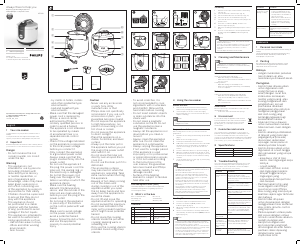


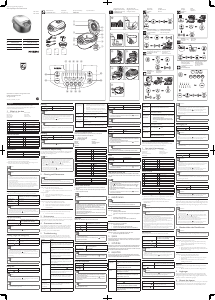
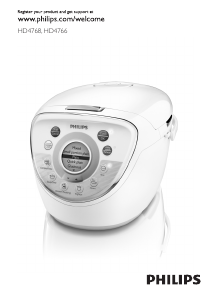
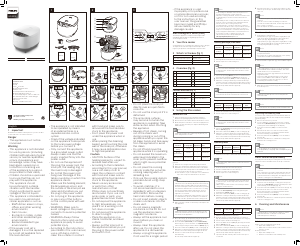
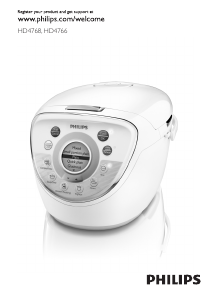

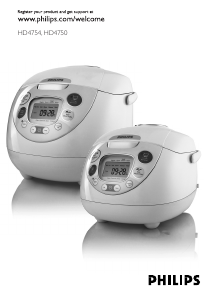
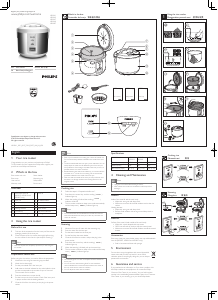
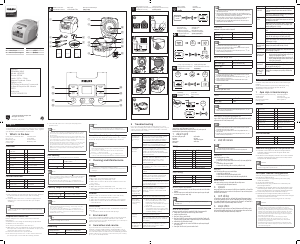
Bergabunglah dalam percakapan tentang produk ini
Di sini Anda dapat membagikan pendapat Anda tentang Philips HD3118 Penanak Nasi. Jika Anda memiliki pertanyaan, bacalah panduan dengan cermat terlebih dahulu. Meminta panduan dapat dilakukan dengan menggunakan formulir kontak kami.